Bonmati and Anglès
 Anglès is the main town that you'll reach if you head almost due west from Girona out along the river Ter. The town is situated on a small hill above the river plain but surrounded by hills, the main ones being the Guilleries Massif that acts as the divider between the plain of Vic and that of Girona.
Anglès is the main town that you'll reach if you head almost due west from Girona out along the river Ter. The town is situated on a small hill above the river plain but surrounded by hills, the main ones being the Guilleries Massif that acts as the divider between the plain of Vic and that of Girona.
(and it's through this range of hills where you'll find a series of spectacular river lakes (the Panta de Susqueda and Panta de Sau) formed from damming the river Ter as it passes through the hills starting at the neighbouring town of La Cellera de Ter).
When we were updating our map of walks, we realised that we haven't really covered this area west of Girona. We have visited and explored, but not actually written anything up, partly because we're not too familiar with the area. The geography is one of long river valleys - the river Ter, the river Llemena, below large sparsely populated hills and more isolated villages, some with high escarpments, making for more linear type walks.
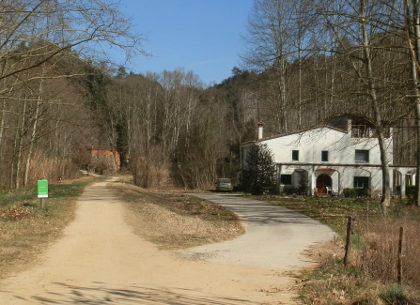 So to try to provide more of a feel of what can be found in this area, we're doing a relatively flat exploratory walk starting in the new town of Bonmati (built in 1990), along the Ter and the Via Verde of the Carrilet that runs along the old railway line from Girona to Olot, and then back via Sant Julia del Llor.
So to try to provide more of a feel of what can be found in this area, we're doing a relatively flat exploratory walk starting in the new town of Bonmati (built in 1990), along the Ter and the Via Verde of the Carrilet that runs along the old railway line from Girona to Olot, and then back via Sant Julia del Llor.
We'd not visited Bonmati before - it's just beyond Bescano along the river, and the road, river and old railway route run close together in parallel. The Via Verde is used as a cycling path and is popular with cyclists who share the gravel track with walkers, some of whom are following the Catalan part of the Route of Saint James as it heads to Santiago de Compestella.
Bonmati isn't much to write home about, a few factories and warehouses and the bulk of the town consisting of new urbanisation housing and a large and very impressive sports centre. However, it's easy to park and connects directly to the Via Verde.
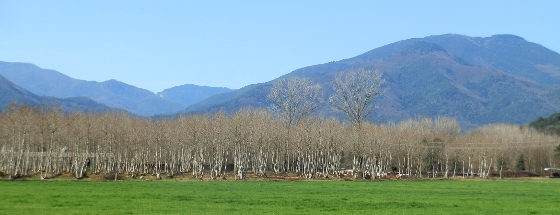
We're currently just pre-Spring and the buds are appearing on the trees, but no leaves at the moment. However, the day is warm and its pleasant to walk in a light jacket, with the blossom appearing on the almond trees.
The walk could be considered more of a stroll as the path is broad and flat with views to the river, which perhaps isn't at its most photogenic time of the year. Because the route is shared with bikes, we keep an eye out for families and other cyclists from both directions. Fortunately they're not fast - the quicker road cyclists can be seen on the road that runs beside the path.
In fact, we're close to the road for a lot of the time as we head to Anglès in the distance, and cars do use it as a main route, to there's a fair amount of noise.
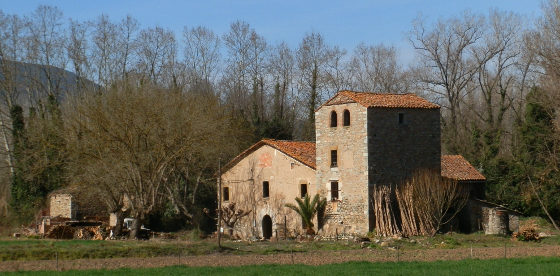
Everywhere around here seems to be allotments or vegetable gardens (horta), with soil carefully weeded and prepared and signs of onions, cabbages and cauliflowers, and bamboo frames for beans and peas. As we get close to Anglès we pass one of the old masia farm buildings (Can Biel) with a large square tower that looks unchanged from the 18th century - rough but sturdy, still farming the surrounding land.
As we get to the outskirts of Anglès we cross the main road (which diverts around the outside), to take a town road towards the centre, the church tower with its four clocks on the rise acting as our target point.
Anglès is a slightly strange mixture of modern, old and, it has to be said, the occasional derelict building. We've visited two or three times in the past, and it's fair to say that efforts are being made to upgrade the town - there is a sense of regeneration. However, Angles like some other communities into the hinterlands west of Girona carry a sense of mixed fortunes.
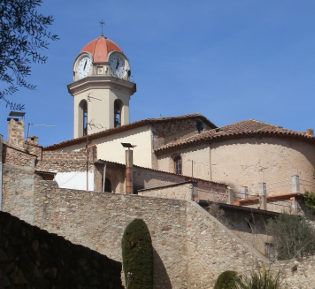 The older buildings and churches are interspersed with crudely built blocks of flats built in the 60s and 70s, and as the towns fortunes waned, some of the older buildings have fallen into disrepair. In more modern times, the money has gone into new buildings in current design, and it feels like it is only recently that older buildings are seeing restoration of their fortunes.
The older buildings and churches are interspersed with crudely built blocks of flats built in the 60s and 70s, and as the towns fortunes waned, some of the older buildings have fallen into disrepair. In more modern times, the money has gone into new buildings in current design, and it feels like it is only recently that older buildings are seeing restoration of their fortunes.
The result is a curious mish mash of styles where a brand new luxury apartment building might stand next what could be a decaying, but potentially very pretty, 1900s modernista building.
Along our route into town we cross a small stream, clearly recently cleaned up, waiting for rain to refill the cleared river bottom of displaced soil. The river itself trickling through, leaving large trout trapped in deeper pools.
And then we double back to the park of Can Cendra, before taking the road up the hill into the older part of the town to the church at the top with views across the town and out to the hills.
 The upper part of Angles is relatively small - the church connects along the old Carrer Major to the main town placa, unfortunately too full of parked cars to be very attractive. Along the Carrer Major, the older buildings have been marked and labelled giving a flavour of the history, but still with the odd mix of well and badly preserved buildings.
The upper part of Angles is relatively small - the church connects along the old Carrer Major to the main town placa, unfortunately too full of parked cars to be very attractive. Along the Carrer Major, the older buildings have been marked and labelled giving a flavour of the history, but still with the odd mix of well and badly preserved buildings.
We navigate down to river level around the back of the placa, and then through the recently updated streets under the church - part of the restoration since last time we visited.
We then head out back towards the river and the large old Bures factory and past the old station. The old train line has been converted into a strolling route, almost a rambla, with tall palm trees marking the route as it passes the old station - the palms being a little incongruous this far inland with the greenery of the surrounding countryside.
 To the left of the station as we're walking we see a large modernista house (Villa Eulalia). It's slightly hidden from view by large trees so we loop back across a makeshift football field and this takes us to the Barri of Cuc - a small group of older houses close to Can Cuc, a beautifully preserved old masia with lovely exterior stonework.
To the left of the station as we're walking we see a large modernista house (Villa Eulalia). It's slightly hidden from view by large trees so we loop back across a makeshift football field and this takes us to the Barri of Cuc - a small group of older houses close to Can Cuc, a beautifully preserved old masia with lovely exterior stonework.
We still want to see more of Villa Eulalia, but it's tucked behind a large gate. However, we can see that it is another one of the older grand buildings now in a poor state of repair with missing glass and out of control vines growing up the wall.
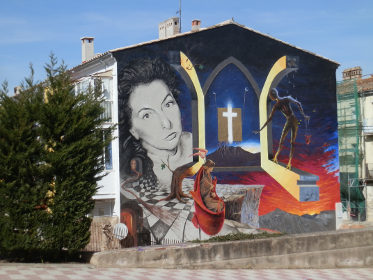 Leaving Anglès we continue a little way along the carrilet again considering whether to head to La Cellera to add the entrance to the Ter river lakes to the walk.
Leaving Anglès we continue a little way along the carrilet again considering whether to head to La Cellera to add the entrance to the Ter river lakes to the walk.
However, instead we cross the road and out to Sant Julia de Llor. The walk crosses the river along the road before turning to the right to Sant Julia, just past the remains of a ancient Roman wall or house. If we'd turned left we'd have reached a Roman bridge, but didn't realise this at the time.
Sant Julia de Llor stands slightly about the fields of the flood plain looking towards Anglès - a simple one road linear village. On the far side we finally return to a track and edge along the bottom of the hill back to Bonmati. It would be possible to go up to the top, but the air is still and the day is getting hot in the shelter of the hillside.
Nearby: Sant Esteve d'En Bas (Olot) - Els Set Gorgs (Campdevanol) - Rupit - Olot - capital of Garrotxa - Swimming and visit to Panta de Sau - Bescano, River Ter and free-style kayaking - Canet d'Adri - Brunyola - Arbucies autumn walk - Volca de la Crosa Sant Dalmai (Girona Airport) - Santa Coloma de Farners
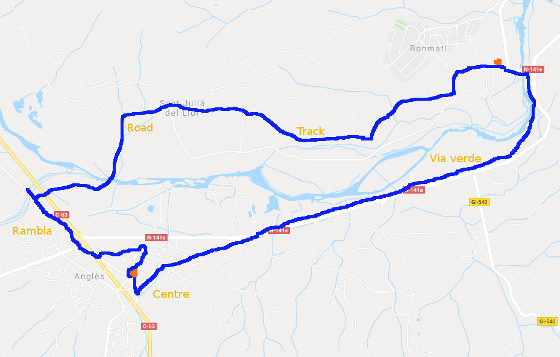

 Walks and other things
Walks and other things